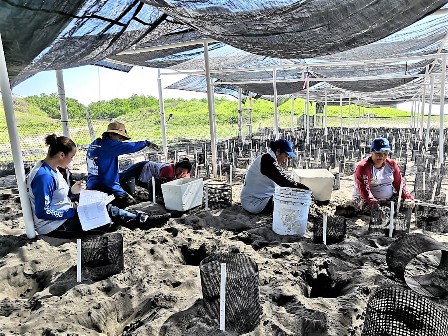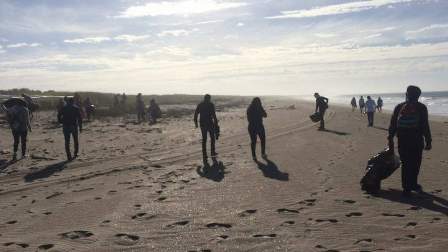Women of El Recreo, sea turtles’ best friends

Protecting sea turtles and keeping their Clean Beach certification is now a personal committment, remark these women working inside a turtle hatchery. Click to enlarge. Click to enlarge. (Photo: Raquel Zapien).
EL RECREO
The women of this outlying community of Mazatlán have become steadfast sea turtle allies, providing hands-on conservation for the endangered olive ridley species and for the environment at nearby El Verde Camacho Beach, one of the most important nesting sanctuaries in Sinaloa.
During the July-November peak season for nesting activities, the women head to the sanctuary, located in Mazatlán’s Marmol de Salcido district, to collect eggs for nest relocation, clean out old nests, record egg hatchings, and liberate hatchlings. Their husbands and other men are on duty from dusk to dawn, patrolling the coastal strip within the wildlife refuge.
The work never ends. Once the turtle nesting season has wound down, the women shift their focus to beach cleanup and maintenance.
For the past decade, they have been working with “El Verde” Sea Turtle Research and Conservation Center, which currently reports to the Northwest and Upper Gulf of California regional branch headquarters of the National Commission for Protected Natural Areas (Conanp).
Community participation has been evolving. These women and other members of El Recreo community have seen that supporting conservation generates environmental, social and economic benefits. So, in 2013 they formed a cooperative to provide ecotourism services that include beach visits, turtle hatchling releases, walks within the mangroves, bird watching, and other water activities.
Forty five year precedent
Scientists Raquel Briseño Dueñas and Daniel Ríos Olmeda began the first research and monitoring actions in the area in 1975.
On Oct. 29, 1986, El Verde Camacho Beach was declared a reserve and refuge site for the protection, conservation, re-population, development and control of several sea turtle species.
The decree set forth a framework for implementation of conservation programs and the operation of sea turtle camps to protect females, eggs, nests and hatchlings, in addition to carrying out scientific research and monitoring activities during the nesting season. This led to the officially sanctioned sea turtle camp, established by Ríos Olmeda, a marine biologist and now coordinator of the project.
Later, on July 16, 2002, a decree published in the Official Gazette of the Federation recognized the beach as a protected natural area (ANP), classified as a “sanctuary”.
Starting in 2012, El Verde Camacho Beach Sanctuary obtained a Clean Beach certification within the category of “conservation priority use” after meeting the requirements of Mexican standard NMX-AA-120-SCFI-2016, which establishes the sustainability specifications for beaches.
The certified section is 4 miles long, the longest of its type in the country. In the last seven years, the beach has enjoyed uninterrupted annual recertification, thanks to community organization and participation in periodic beach clean-ups.
Ramsar site strengthens protection
On Feb. 2, 2004, El Verde Camacho was recognized as Ramsar site No. 1,349 and placed on the list of the world’s most important wetlands. According to the Ramsar Sites technical sheet, it encompasses an area of 15,948 acres.

"We are giving life to a defenseless animal”, declares Susana Tirado Luna. Click to enlarge. Click to enlarge. (Photo: Raquel Zapien).
The application for inclusion was made a year earlier by researcher Briseño Dueñas, head of the Sea Turtle Information Bank for the Marine Sciences and Limnology Institute at the National Autonomous University of Mexico’s Mazatlán campus.
Countries that have Ramsar sites are committed to strengthening the conservation of wetlands, coastal habitats, and the species inhabiting them, such as sea turtles, which are threatened worldwide due to poaching, habitat loss, contamination, and over-exploitation.
In this context, the active participation of communities in conservation programs is noteworthy.
Community members join hands
Ríos relates that the collaboration of the residents has taken place gradually; first, through temporary employment programs (PET) for cleaning beaches or through community brigades and productive projects promoted by Conanp.
Later on, even after budget cuts, people continued to do the work without financial compensation.
Susana Tirado Luna registered with the PET at the invitation of her aunt, Gabriela Díaz, who always encouraged the community to participate and supported the efforts for the original certification of the beach.
After the death of her aunt, Tirado Luna assumed leadership and recruited more people. Ten women now come regularly to the camp to help during the peak nesting season. During this five-month period, an average of 2,200 to 2,500 nests are rescued (relocated and protected), depending on the weather.
“It is like giving birth. We are giving life to a defenseless animal," she says, while recording the daily hatchings in the log. Sitting in the sand, her companions extract the hatchlings from the nests, count them, and separate out the eggs that never hatched.
Mothers, daughters, aunts, grandmothers—all help in the work of the camp, under the supervision of operations technician Julio César González Palacios.
When financial resources are available, the women earn 100 pesos a day (about US $5) for shifts that start at seven in the morning and last until three in the afternoon. When the money ends, the work does not, although this means they will not be paid for their labor.
Saving sea turtles and maintaining Clean Beach certification is now a personal commitment, the women remark as they go about their tasks inside a nursery.
“In conservation work women participate more than men and their influence is clearly evident. Today they are the ones carrying the baton,” González Palacios acknowledges.
Tourist cooperative unfolds
Tourist attractions at El Verde Camacho include wide beaches that still have their dunes, something rarely seen in large tourist developments.
Long stretches of sand border mangroves that can be traversed by boat or kayak. Along some stretches, the branches of these aquatic trees intertwine with each other to form tunnels leading to open waters where it is possible to watch fish and even some crocodiles that are used to human presence.
Moving through these waters, it is possible to observe herons and other birds resting or feeding; green and blue dominate the landscape.
When turtle nesting season arrives, visitors can release hatchlings and learn about the camp’s conservation activities, which include: monitoring of turtle nesting, nest relocations and incubation of nests, and environmental talks for students from nearby towns and various educational institutions.

Students from nearby schools help clean the beach by hand. In exchange, they get to release the last hatchlings of the season. Click to enlarge. (Photo: Cooperativa Rural Servitur El Verde Camacho).
The tourist activities are offered for small groups of five to 10 people who are guided by members of El Verde Camacho Rural Cooperative Service, which is made up of six women and eight men from the community, under the coordination of Efraín Ramírez Tirado.
Before venturing into ecotourism as a livelihood, Tirado Luna comments, the service members were trained in administration, organization and conflict resolution. Biologist Ríos helped them obtain the necessary resources to do so from the Conservation Program for Sustainable Development at Conanp. Training included a first aid workshop.
“We offer courses on everything so that there is no envy or any quarrels; we all agree on what we do; we have learned different skills,” Tirado notes.
Ecotourism services are regularly offered once or twice a week throughout the year, but especially from October to February, during the peak tourist season.
Beach showcases biodiversity
El Verde Camacho Beach Sanctuary is a narrow coastal swath with an approximate area of 6,454 hectares (15,948 acres), which include estuaries, lagoons and rivers, according to Conanp. The wetland is fed by the seasonal flow of the 60-mile-long Quelite River.
The turtle camp located here has an incubation area and a nursery, a covered corral for the clutches that have been relocated, as well as an area to provide environmental education to students, community groups and other visitors.
Camp technician González notes that the monitoring tasks are carried out along more than 11 miles of beach.
According to the Ramsar fact sheet, El Verde Camacho is an index beach for the olive ridley turtle, (Lepidochelys olivácea), which means that it is important for monitoring nesting levels of this endangered species in Mexico, and the changes in its abundance.
It is also a feeding zone and migratory corridor for the hawksbill turtle (Eretmochelys imbricata) and the black turtle (Chelonia agassizi). The leatherback turtle (Dermochelys coriácea) nests here sporadically. All of these are listed as endangered in NOM-059-SEMARNAT-2010.
The area’s wetlands are used as feeding, breeding, and nursery grounds as well as for refuge by a wide variety of other species, among these both resident and migratory birds, reptiles, and land mammals. According to Conanp, the wetlands also see high levels of migration of commercially valuable marine organisms, including a variety of fish species, lobster, shrimp, octopus and oyster.
Problems persist
As documented in the Ramsar Site registry, despite its biological importance, the turtle sanctuary is affected by pollution from both livestock and fish farming, vehicular traffic within the beach areas, construction, and artificial lighting.
Additionally, the location of El Verde Camacho is incorrectly recorded in the decrees that protect the area, which identify the sanctuary as being within the jurisdiction of both the Escuinapa and Rosario municipalities, rather than Mazatlán.
Conanp has requested that the area be re-surveyed using precise territorial georeferencing instruments and that the declared boundaries be modified accordingly.
Participants glean rewards
The last turtles arrived to lay their eggs on the beaches of El Verde Camacho in February, their numbers low because the peak of the season (July to November) was long past.

Members of El Recreo community have learned that betting on environmental conservation pays off in environmental, social and economic benefits. Click to enlarge. (Photo: Cooperativa Rural Servitur El Verde Camacho).
In March, work started on beach cleanup in order to begin the annual process of recertification that is granted by the Mexican Institute for Standardization and Certification. The women involved are: Gabriela Aguilar, María Cristina Tirado, Casilda García Carrasco, Magaly Tirado Ramírez, Victoria Tirado, Norma Alicia Juárez, Claudia Raquel García, María Félix Escobar, María Auxiliadora Alvarado and Susana Tirado Luna. Also involved are Efraín Ramírez, Luis Ramírez Tirado and Juan Ramírez Reyes.
And like in every year, students from nearby schools join in. In exchange, they get to release the last hatchlings of the season.
It takes time to maintain the camp, the roads, the estuary, and the community garden that they have created together.
At the end of a day’s work, the women say they are satisfied with the results of their conservation efforts. Now, they attend national meetings to share their experience with other communities and turtle camps in the country.
Together with their families, they are convinced that they must take a hand in preserving their greatest treasure, the natural heritage that sustains not only life itself but also the productive capacity of the region’s economy.
